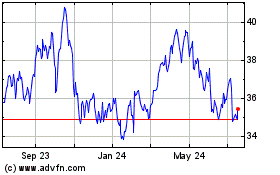BP Shares, Boosted by Higher Oil Prices, Hit Eight-Year High -- 3rd Update
May 01 2018 - 7:15AM
Dow Jones News
By Sarah Kent
LONDON -- BP PLC shares rose to their highest level since 2010,
boosted by frothy oil prices that have helped return the stock to
levels not seen since the month after the Deepwater Horizon
disaster.
Like the handful of big oil firms that have already reported in
recent days, London-based BP benefited handsomely from recently
lofty oil prices. It also reported rising production, helping it
post its strongest quarterly earnings since the middle of 2014.
Tuesday's solid first-quarter results could go some way toward
convincing investors that BP's ambitious plan to regain its
position among the world's top energy companies is gaining
steam.
BP's shares rose more than 1% in early London trading, after
touching a high of GBP5.48, or about $7.50. The last time the
company's share price was at that level was in the immediate
aftermath of the Deepwater Horizon explosion in April 2010. The
disaster killed 11 and sent oil spewing into the Gulf, resulting in
the worst offshore oil spill in U.S. history.
BP's shares hit a two-year high of GBP6.58 on April 21, 2010,
the day after the explosion but before investors had a firm handle
on the scale of the disaster. It quickly hurtled lower, hitting a
low of GBP2.96 in June 2010.
Then-Chief Executive Tony Hayward resigned the following month,
and BP started what would turn out to be a multiyear,
multibillion-dollar effort to recover. To pay for cleanup costs and
legal fees, BP was forced to sell off billions of dollars in
assets, dramatically shrinking the size of the company. To date,
the spill has cost BP more than $65 billion.
It agreed to a landmark $20 billion deal to settle all federal
and state claims for the accident in 2015. Since then, executives,
including Chief Executive Bob Dudley, have tried to turn the page
on the disaster. Part of that effort has been a plan to return its
oil-and-gas production to 4 million barrels a day, while boosting
profits and cash flow.
The company said Tuesday its replacement cost profit -- a number
analogous to the net income that U.S. oil companies report -- was
$2.4 billion in the first quarter, compared with $1.4 billion in
the same period a year earlier. The last time it reported profits
of that size was in the third quarter of 2014 when oil prices were
hovering near $100 a barrel.
In addition to its Deepwater Horizon woes, BP suffered with the
rest of the industry through years of low oil prices. Oil prices
fell to as low as about $25 a barrel by 2016, though have recovered
strongly since then. International crude is now trading near $75 a
barrel.
The company's production, meanwhile, rose 6% in the first
quarter compared with a year ago. BP started a record number of new
projects around the world last year and is planning to begin
production at six more in 2018, part of a plan to add 900,000
barrels a day of new production by 2021. The strategy puts it on
track to return output to its pre-Deepwater Horizon levels of
around four million barrels a day, by the early 2020s. On Tuesday,
it said it pumped 3.7 million barrels a day in the first
quarter.
The company's Chief Financial Officer Brian Gilvary also raised
the prospect that BP could consider raising its dividend in the
second half of the year as it expects debt levels to come down. It
kept its payout unchanged for the first quarter.
But BP still hasn't escaped the financial liabilities that have
hobbled it since Deepwater Horizon. The company said it paid out
$1.6 billion in the first quarter related to the accident. That
included the final installment from a settlement with the Justice
Department to resolve all criminal claims. In total, payments are
expected to total just over $3 billion in 2018. The company then
faces charges of about $2 billion next year, and then more than $1
billion a year out past 2030.
BP caps a mixed earnings season for the world's biggest oil
companies. Exxon Mobil Corp., Chevron Corp. and Royal Dutch Shell
PLC posted their best first-quarter profits in years, but investors
remained skeptical of companies that failed to meet expectations
during three months when oil prices reached their highest level
since 2014.
Write to Sarah Kent at sarah.kent@wsj.com
(END) Dow Jones Newswires
May 01, 2018 07:00 ET (11:00 GMT)
Copyright (c) 2018 Dow Jones & Company, Inc.
BP (NYSE:BP)
Historical Stock Chart
From Mar 2024 to Apr 2024

BP (NYSE:BP)
Historical Stock Chart
From Apr 2023 to Apr 2024
